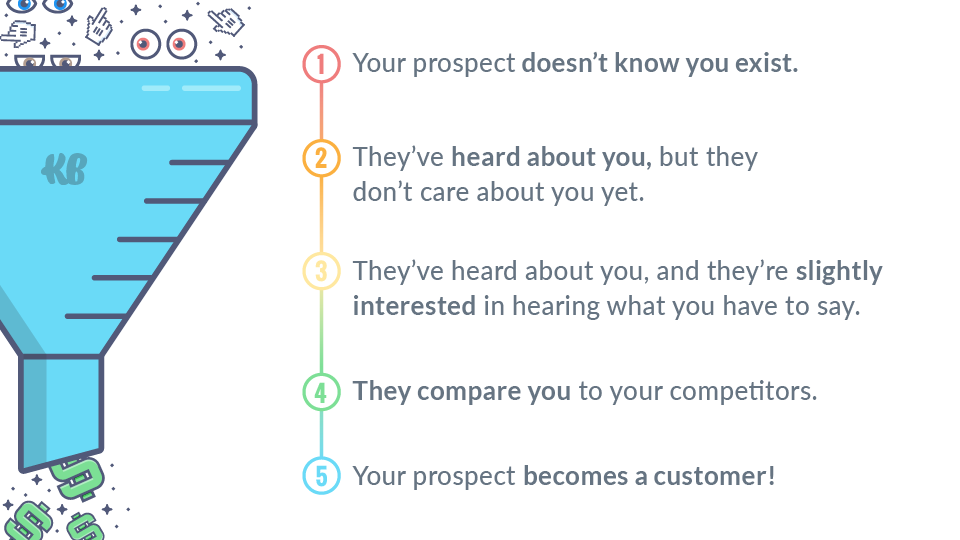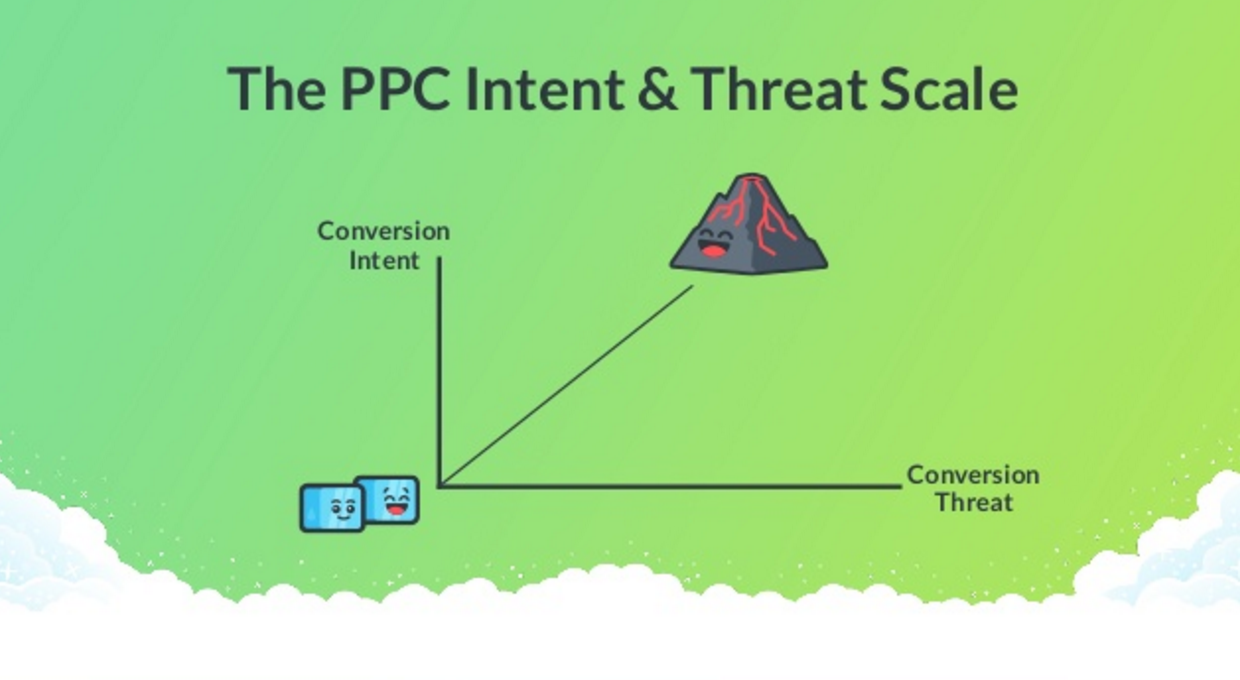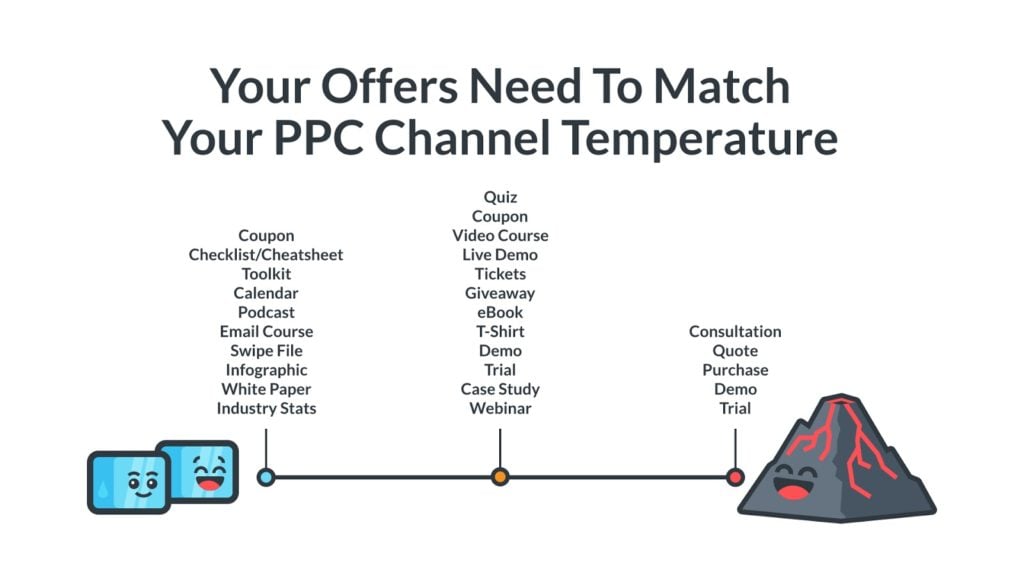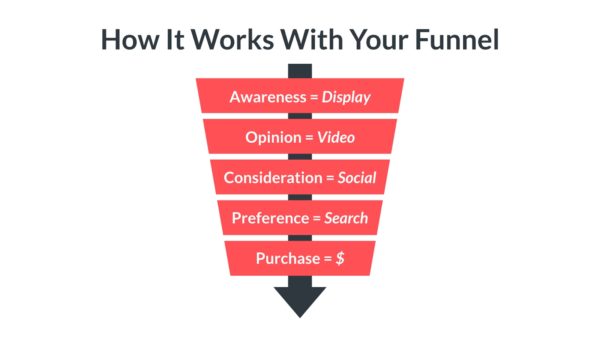Writing ad copy successfully for AdWords should be easy.
There’s only a few characters required. You’d think that would take a minute or two.
And yet therein lies the problem.
It’s incredibly difficult to jam everything in just a few words. Your ads need to entice readers to click, but then also somehow match landing pages, too.
Fortunately, there are a few tricks you can use...a few tried-and-true ideas that we've learned from testing with over 100 clients at KlientBoost.
Here are 10 ad copywriting hacks with 100 tricks that will make sure you get it right on the very first try.
Get brand new Google ad strategies straight to your inbox every week. 23,739 people already are!
1. Decision making funnel stage
Average ecommerce conversion rates hover around 1-2%.
So, what are the other 98-99% of the people doing when they hit your site? They’re looking, searching, browsing, comparing, evaluating, and more. Basically everything except buying.
Each individual visitor is at a different point along their own journey. Which means they each have different problems or pain points on their minds. The Search Buying Cycle mimics this buyer’s journey you’ve read all about already.
People in the first group have a problem. They’re just becoming aware of a need in their life, but not yet looking for (or even knowledgeable enough) about a solution.
The second group is a little further along and starts entertaining the idea for a solution while the third is focused on making a decision.
Many ad problems start because you’re advertising the wrong thing to the wrong person at the wrong time. That’s the reason why advertising a car valuation calculator to someone searching for “broken transmission” doesn’t work.
The ad itself might be flawless. The offer impeccable. But your alignment is off. (Cars - alignment, get it?!)
It simply doesn’t appeal to them. Not yet anyway, because they haven’t yet decided (or realized) that they’d be better off selling their car. Instead, they’re still stuck thinking about trying to salvage what they’ve got.
Now, that doesn’t mean the car valuation calculator offer won’t work. In fact, a few simple tweaks could move it ‘up’ in the search buying cycle to appeal to people still firmly stuck in the Awareness stage.

You just need to adapt the messaging to become a little more appropriate to where they are and what they’re seeking. Like so:
You’re targeting people in the first stage. But you’re about to move them into the second.
Then, all that’s left is to match the specific offer you’re advertising to each person’s ‘temperature’.
Here’s how that works.
2. Match your offer with their ‘Temperature’
Ads are up-and-running.
The headline is clever, but clear. Compelling, of course. Copyhackers would approve. Yet, customers aren’t clicking.
The problem is that the thing you’re advertising (the offer) doesn’t align with the individual's temperature.
Here’s what I mean.
We just learned that funnel stage dictates what copy to use. People at the top don’t yet know you exist. People in the middle are becoming more familiar while those at the end compare you to alternatives before buying.
When you figure out which stage searchers are in, and then align each with the appropriate offer, magic happens.
We’ve developed our own PPC traffic intent, threat, and temperature scale that you can use to help craft PPC copy that, in turn, forces people to click. This PPC scale helps to ‘put ourselves in the visitors shoes’ and determine the intent level of each searcher by what ad type they’re using.
For example, display ads (typically) appeal to cold, unaware traffic. Same goes for video and social. People discover these by ‘accident’; it piques their interest while they’re browsing and checking out other stuff.
But when they switch to Search, they mean business. Now, they’re intently looking for a solution.
This is supported by Google’s own Customer Journey to Online Purchase tool. It shows channels on the left that ‘assist’ in driving conversions (i.e. helping people discover more about who you are) before switching to more ‘intent’-driven channels (i.e. searching for your brand name).
Ok… so what do you do with this information? (Ha -- you almost said doodoo.)
You align your offer to the temperature.
That’s why coupons or cheatsheets entice new browsers. These people want some quick instant gratification. And they’re not yet willing to fill out a long form or sit through an hour+ webinar (like those who’re actively comparing alternatives might).
Back to our “broken transmission” example.
The messaging can still work. (Fixing your transmission is expensive. Here’s why you should sell to us instead of replacing it.) But a visual infographic or ebook is a better incentive for cold traffic who’s not ready to invest the commitment required for filling out a full-length calculator just yet.
This also dictates what keywords people will use when searching.
For example you will see the following:
Problem-focused keywords up top (e.g. “fix”, “replace”, “troubleshoot”).
Solution-oriented ones in the middle (e.g. “optimize”, “tool”).
And purchase-ready ones down below (“quotes”, “pricing”, “proposal”).
3. Specific, verifiable numbers
There’s one thing you can always count on when looking for a new restaurant: The place boasting “world famous” anything, isn’t.
It’s a classic tale. The “#1 Move of the Year” is going to score a 13% on Rotten Tomatoes. And the “World’s Best Cup of Coffee” is stale, luke-warm Folger's out of a Costco tin.

There’s a reason 92% of people trust recommendations from others -- even if they don’t know them personally -- as opposed to a brand themselves: because brands are typically lying liars who lie.
But numbers change all that.
They’re verifiable. So, people can quickly tell if they’re true or not. And exact (as opposed to rounded) numbers are also more believable. Believe me.
“People believe exact numbers more so than they believe rounded numbers,” according to The Negotiation Experts’ Roger Dawson. “The Ivory Soap people learned this out decades ago when they started claiming, ‘Ivory Soap is 99.44 percent pure.’”
The age-old “Worlds Best” approach would have been to claim “100%” purity. But that would obviously be complete B.S. to most smart consumers.
For example, we used exact numbers with AskNicely (a response rate percentage) and the conversion rate jumped 163%.
The best headlines are ultra-specific. They make a promise. And there’s no better way to be more specific then by adding numbers which indicate exactly how much, how many, or what it’s going to set you back.
Travel companies, like Trivago, take this to the extreme by illustrating everything from room class, to quantity of hotel rooms, and cost per night with numbers in their ads.
Trivago also uses a tip from Outbrain that discovered odd numbers outperform even ones by 20%.
4. Hyper Local
There’s a saying about Search:
You can’t manifest demand. You can only harvest it.
Here’s what that steaming pile of jargon means.
People already search for things specific ways. And there’s not a whole lot you can do to change or influence how they’re going to search. You can only react to what they’re already doing to take advantage.
Local business queries are a perfect example. People like doing business in-person. That’s why face-to-face close rates outperform phone ones which outperform website-based ones.
Even something like ‘tax relief’, which technically isn’t bound by location, becomes a location-based search when people start looking for a local provider to do business with.
Fortunately, using location-based queries + geotargeting can help you laser-focus campaigns.
For example, look at what happens when you look for “flowers” in “Irvine”:
“Irvine” pops up in each ad. Two of the four get extra credit for using “Irvine” in the URL. And another emphasizes “local” as the differentiator.
The expanded headline is a perfect place to work in the location qualifier, too. Re-writing ads to include an additional benefit in this expanded format can provide a 400% CTR leap.
The extra space also makes it easy to work in both the location and a compelling value prop.
This ‘local’ preference doesn’t just stop at text alone, though. Extensions, like the phone number you’d use, can also be tailored for location.
We’ve found that using an area code that matches a searcher’s can increase the chances of a phone call double (if not more).
5. FOMO
Most Google searches aren’t life or death.
The person on the other end of the line doesn’t NEED that thing they’re searching for ASAP.
Which makes conversions tricky. You need to create a sense of urgency out of thin air in order to move the needle, especially when even a tiny bit of urgency can increase product revenues by 27%.
FOMO is one of the best ways. Take limited quantities or deal expiration dates, which create an artificial deadline in the mind of a prospect, to generate that fear of missing out.
Loss aversion is one of the most powerful weapons we have to get someone to make a definitive decision (quickly). Even this simple and relatively vague “Ends Soon” from Simply to Impress starts making you a little anxious.
Woah. I suddenly want unique, personalized graduation announcements with photos for as low as 62 cents in 300 cool designs.
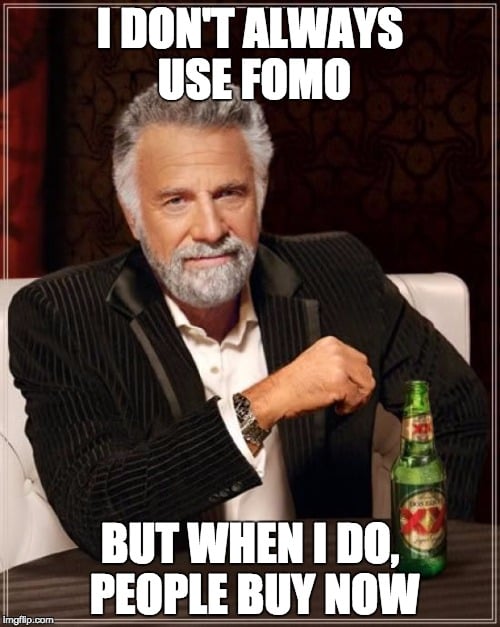
Ok, but seriously. Here’s what they’re doing that works so well:
- Tip #1. A Big Ol’ Discount. Sometimes there’s no need to overthink it.
- Tip #2. Specific Numbers. Already covered that point.
- Tip #3. Action-Oriented Words. And here’s where explicit CTA’s come into play.
We’ll cover that next.
6. Explicit CTA
People online are distracted.
For example, you’re probably not even reading this right now.
Case in point: You know all those browser tabs you have open right now? They’re literally making you brain dead. It feels like you're working. But in reality, it’s sinking your productivity.
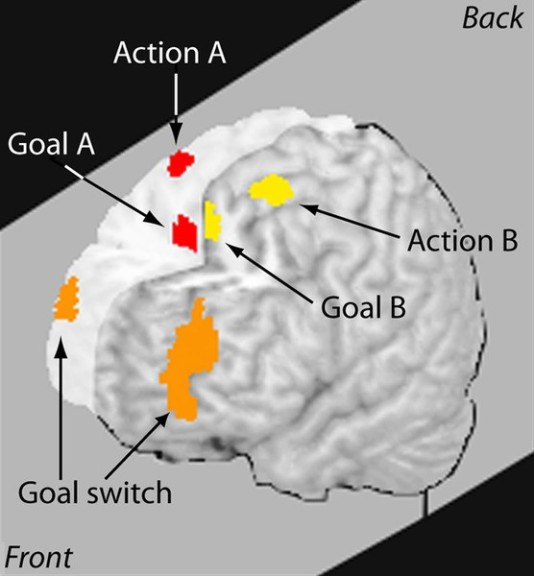
That makes it incredibly challenging to write ads that get people to focus, to pay attention long enough that they do what you want (like click or buy).
The antidote? You need to use explicit language that tells them what to do.
Right freaking now.
Explicit CTA’s use simple, action-oriented words that cut through distractions to speak directly to our primal motivations.
LunaMetrics excellently highlights how to add some of these FOMO-inducing CTA words to targeted keyphrases in this image below.
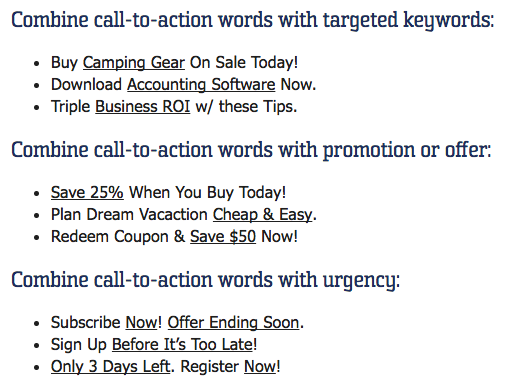
Now, take another look at this SERP to see how the first two (Tiny Prints and Shutterfly) feature explicit CTA’s that grab your attention (over the yawn-worthy Hallmark one below them).
7. Dynamic keyword insertion
Website browsers are banner blind. Meaning, they tend to scan and ignore anything that remotely resembles an ad.
That’s only part of the problem, though.
Because the other half is that people are also proactively trying to prevent ads in the first place.
The reason is irrelevance. The ads don’t appeal to people, so they’re less inclined to pay attention (or even tolerate them).
Google recently unveiled IF Functions as one potential solution. This handy little feature helps you automatically personalize ad text, depending on what someone searched for. That way, searchers should almost always see something that appeals to them.
For example, you can create ad text that explicitly targets the device people are on to help entice impulse buys.
You can use these dynamic keywords to personalize for the product they’re searching for (e.g. “HD tv” vs. “55-inch TV” vs. “really awesome curved TVs that look great from all angles” - WTF do you call those anyway?!).
And you can even personalize ad text based on the location-based search someone is using for local cities (see #4 above).
So, you can take the same ad used for “Costa Mesa”...
… and swap out some text for “Newport Beach”...
Sounds promising, right?
But there’s a caveat to finding success with dynamic insertion like this.
Most of our clients have found success with IF functions when combined with RLSA audiences.
Here’s why.
8. RLSA Audiences
We’ve already learned that most people don’t buy on their first purchase. That was covered ALLLL the way back in hack #1.
Even getting people close to that metaphorical finish line (like adding a product to their cart) can take a lot of work (and money). So, the last thing we want is a cart abandonment at this stage in the game.
Remarketing lists for search ads (RLSA) are perfect for saving those people who expressed ‘high intent’ actions but didn’t follow through for whatever reason. So, they give us another shot. Another chance to get them to come back and buy.
CMO.com reports that “retargeted visitors are 70% more likely to convert compared to ones who aren’t.” So, if you’re looking for a place to better leverage time and money, it’s on these people who’ve already subtly told you (through their actions) that they’re kinda interested in what you’ve got.
One technique is through sequential retargeting, where you show a variety of different offers (that build on each other) in order of both value and commitment level.
But you can also segment based on what channel they’re using and what that tells you about where they are:
Point is that combining the power of RLSA with IF Functions will super-charge your remarketing efforts. For example, if someone placed a product in their cart but left, you can knock a few extra percentage points off in order to push them over the edge.
So, while you would normally follow the competition’s lead with matching price or discounts, you know that an additional discount for only those who’ve previously expressed the right interest on your site can make all the difference.

9. Questions?
MarketingExperiments.com compared two simple AdWords headlines.
The Control version was a question designed to pique the searcher’s interest. While the second Treatment was a declarative statement focusing on the benefits.
In this scenario, the question (Control) outperformed the statement (Treatment) by over 36%.
In their words, “The objective of a headline is not to sell, but to reach out and connect with the reader, and pull him or her into reading more.”
And there’s almost no better way to pique someone’s interest than with a question,especially when you combine them with a few other tips we’ve covered on this list (like specific, verifiable numbers).
This CrazyEgg example combines the intrigue of storytelling, with quantifiable numbers, and the irresistibility of a question.
Sure. It’s BuzzFeed-y.
But if your goal is top of the funnel awareness-building, this style in the form of a question is the perfect solution.

Any questions?
But seriously, check out this perfect example from Alka-Seltzer.
You’re sick. Flu-like symptoms. But need to carry on, make it to the office, and make sure the kids get to school on time. You simply can’t afford to take the day off.
At this point in time, at the very beginning of your awareness journey, you’re not yet Googling doctors’ offices.
Instead, you’re trying to find out more information about the symptoms you’re exhibiting, which is where Alka-Seltzer cleverly inserts themselves (with a question).
Same idea, different example...
Your tooth hurts. You haven’t been to the dentist for a better part of a decade (just me?). So, you’re not Googling offices just yet, but instead trying to find out what causes this kind of pain and what you can do about it.
Enter Advil.
You’re probably wondering, does simply restating the problem as a question really induce clicks or increase CTR?
Why, yes, yes it does.
We ran a similar test to the original MarketingExperiments.com one above with this AskNicely example:
Simply restating the problem as a question in the headline helped increase conversion rates by 67% while also skyrocketing their CTR by 219%.
10. Mobile specific
It’s official.
Mobile searches and Internet usage outpace those on your desktop. Here’s why that’s important.
Hitwise examined hundreds of millions (holy crap that’s a lot) of searches to come to this conclusion. Here’s the data from the share of online searches initiated on a mobile device, sorted by industry:
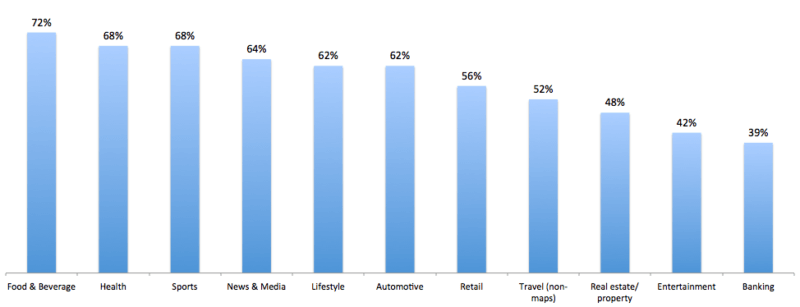
Searchers (unsurprisingly) search differently on mobile devices.
That can be a good thing, or a terrible thing, based on your PPC copywriting. And that’s why device-specific campaigns should also get their own ad text treatment, too.
For example, you can use the ad text customizers from AdWords to make sure your headlines are adjusted accordingly on smaller screens.
Size restrictions aren’t the only reason, however.
For example, when a study compared ad title case across each device they made another surprising discovery.
Title case (Like This) seemed to increase readability on those smaller screens. So, they saw a higher CTR and average position (for less).

Pro Tip: You’re limited to choosing Mobile vs. All. So, create two separate ads for each one to make sure each is exploiting the best of both worlds.
Wrap up on ad copy tricks
PPC ad writing doesn’t work like TV or radio.
Simply claiming your product is “Best in Class” isn’t good enough. “The World’s Best,” you surely aren’t. And savvy searchers today completely ignore meaningless sentiments like that.
Instead, the devil is in the details.
You first need to understand what stage of the funnel someone’s in, so that you can match the appropriate offer to their ‘temperature.’
Then, you can get specific and tactical with things like FOMO, explicit CTAs, verifiable numbers, question-based headlines, and mobile specific ones, too--or even more clever with dynamic keyword insertion + RLSA audiences.
The solution to better advertising results isn’t by creating more ads. It’s by creating better ones.



